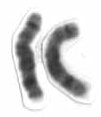8p23.1 duplication syndrome
| 8p23.1 duplication syndrome | |
|---|---|
| Other names | Dup(8)(p23.1p23.1), Trisomy 8p23.1 |
 | |
| Chromosome 8 is associated with this condition | |
8p23.1 duplication syndrome is a rare genetic disorder caused by a duplication of a region from human chromosome 8.[1] This duplication syndrome has an estimated prevalence of 1 in 64,000 births[1] and is the reciprocal of the 8p23.1 deletion syndrome. The 8p23.1 duplication is associated with a variable phenotype including one or more of speech delay, developmental delay, mild dysmorphism, with prominent forehead and arched eyebrows, and congenital heart disease (CHD).[2][3]
Presentation
The phenotypic data on 11 patients indicated that cases are not always ascertained for
Genetics
The duplication includes ~3.75 Mb between the distal and proximal ORDRs at either end of band 8p23.1. The copy number of the adjacent repeats may also be altered. The 8p23.1 duplication syndrome cannot be distinguished using conventional cytogenetics from high level copy number variation of the repeats themselves.[1][2]
Both de novo cases and families with transmitted duplications from parents of both sex are known. The duplication is believed to arise de novo as a result of non-allelic homologous recombination (NAHR) between the proximal and distal ORDRs. NAHR is also thought to give rise to the reciprocal microdeletion syndrome, the polymorphic inversion between the ORDRs and a variety of other large scale abnormalities involving the short arm of chromosome 8.[6]
Diagnosis
Phenotypes
| Primary | Secondary | Tertiary |
|---|---|---|
| NEUROLOGY | MENTAL, COGNITIVE FUNCTION, general abnormalities | intellectual disability/developmental delay |
| VOICE | Voice, general abnormalities | Speech delay |
See also
- Chromosome 8 (human)
